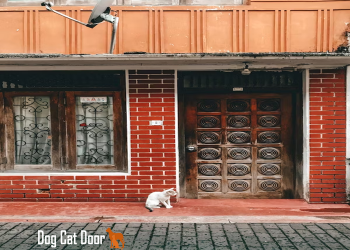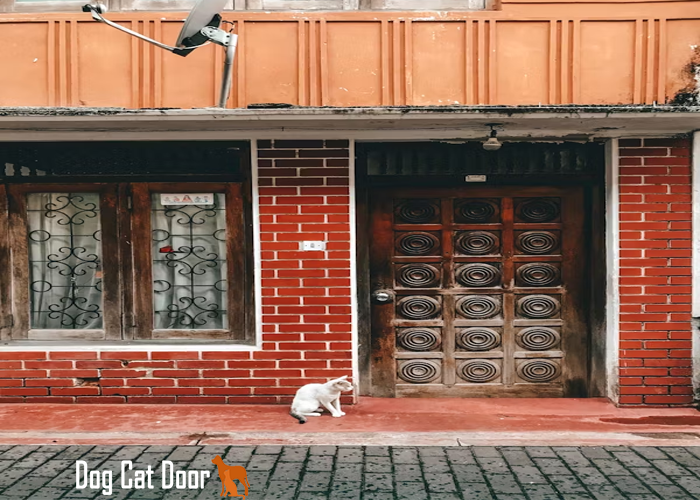Discover the top 10 Perfect Cat Door Dog Gate for pet-friendly homes. Learn about installation, security features, and choosing the right size for your furry friends. Find the perfect balance between convenience and safety with our comprehensive guide. Are you a proud pet parent looking for ways to give your furry friends more freedom while keeping your home secure? Look no further!
In this comprehensive guide, we’ll explore the world of cat doors and dog gates, two essential tools for creating a pet-friendly living space. From electronic cat flaps to adjustable dog barriers, we’ve got you covered with everything you need to know about these handy pet accessories.
Why Cat Doors and Dog Gates are Essential for Pet Owners
Let’s face it: our pets are family. And just like any family member, they deserve the freedom to move around comfortably in their own home. But how do you balance that freedom with the need for security and control? Enter cat doors and dog gates – the unsung heroes of pet-friendly households.
Cat doors, also known as cat flaps, are small openings that allow your feline friends to come and go as they please. They’re perfect for indoor-outdoor cats who like to explore but always come home for dinner. On the other hand, dog gates are barriers that help you manage your canine companion’s movements within your home. They’re great for keeping dogs out of certain areas or separating them from other pets.
But why are these products so important? Well, imagine never having to get up at 3 AM to let your cat out for a midnight prowl. Or picture being able to cook dinner without your enthusiastic pup underfoot. Sounds pretty good, right? That’s the magic of cat doors and dog gates – they give you and your pets the best of both worlds.
Types of Cat Doors: Finding the Purr-fect Fit
When it comes to cat doors, one size definitely doesn’t fit all. There’s a whole world of options out there, each with its own unique features. Let’s take a look at some of the most popular types:
- Manual Cat Flaps: These are the simplest and most affordable options. They’re basically small, hinged doors that your cat can push open with their nose or paw. While they’re easy to install and use, they don’t offer much in terms of security or selective entry.
- Magnetic Cat Doors: These clever contraptions use a magnetic key attached to your cat’s collar to unlock the door. They’re great for keeping neighborhood cats out while giving your own kitty easy access.
- Microchip Cat Flaps: The high-tech option for discerning felines! These doors read your cat’s microchip (or a special collar tag) to grant entry. They’re super secure and can be programmed for multiple cats.
- Electronic Cat Doors: These battery-operated wonders can be set to lock and unlock at specific times. Some even come with remote controls, letting you decide when your cat can venture outdoors.
- Sliding Glass Cat Doors: Perfect for renters or those who don’t want to cut into their walls, these doors fit into the track of a sliding glass door. They’re removable and don’t require permanent installation.
Dog Gates: Barking Up the Right Tree
Now, let’s turn our attention to our canine companions. Dog gates come in all shapes and sizes, just like our furry friends. Here are some popular types to consider:
- Pressure-Mounted Gates: These gates use tension to stay in place, making them ideal for renters or temporary situations. They’re easy to install and remove without damaging your walls.
- Hardware-Mounted Gates: For a more permanent solution, these gates are screwed directly into your walls or doorframes. They’re super sturdy and great for the top of stairs or other high-traffic areas.
- Freestanding Gates: These portable barriers can be moved around as needed. They’re perfect for creating temporary play areas or blocking off outdoor spaces.
- Retractable Gates: When not in use, these gates roll up into a compact unit. They’re great for tight spaces or homes with a modern aesthetic.
- Extra-Tall Gates: For those big jumpers or climbers, extra-tall gates provide an added level of security. They’re typically 36 inches or higher.
Installation Made Easy: Setting Up Your Cat Door
So, you’ve chosen the perfect cat door. Now what? Don’t worry, installation is usually simpler than you might think. Here’s a basic rundown of the process:
- Choose the right location: Pick a spot that’s easily accessible for your cat but doesn’t compromise your home’s security.
- Measure twice, cut once: Carefully measure the opening you’ll need and mark it on your door or wall.
- Cut the hole: Use appropriate tools (usually a jigsaw) to cut the opening. Take it slow and steady!
- Install the frame: Most cat doors come with a frame that fits into the opening you’ve cut. Secure it in place according to the manufacturer’s instructions.
- Test it out: Before letting your cat use it, make sure the door opens and closes smoothly.
Remember, if you’re not comfortable with DIY projects, it’s always best to call in a professional. After all, we want your cat door to be safe and secure for years to come.
Dog Gate Installation: No Bones About It
Installing a dog gate can be even easier than setting up a cat door, especially if you opt for a pressure-mounted or freestanding model. Here’s a quick guide:
- Measure your space: Make sure you know exactly how wide your doorway or hallway is before buying a gate.
- Choose your gate: Pick a gate that fits your space and meets your needs in terms of height and security.
- Assemble the gate: Most gates come in pieces and need to be put together. Follow the instructions carefully.
- Install the gate: For pressure-mounted gates, extend the bumpers until the gate is secure. For hardware-mounted gates, mark your screw holes, drill pilot holes, and securely attach the gate to your walls.
- Test the latch: Make sure the gate opens and closes easily for humans, but stays securely shut when pushed by your pup.
Security Features: Keeping Your Home Safe and Sound
Now, I know what you’re thinking. “Won’t a cat door compromise my home’s security?” It’s a valid concern, but modern cat doors come with a variety of security features to put your mind at ease.

Many electronic and microchip cat doors can be locked, preventing entry from outside. Some even have timers, so you can set them to lock overnight. For added peace of mind, consider installing your cat door in a less visible location, like a side or back door, rather than your main entrance.
As for dog gates, their primary security function is keeping your dog where you want them. However, some sturdier models can also act as a deterrent to intruders. Just remember, a dog gate is not a substitute for proper home security measures.
Choosing the Right Size: A Tail of Proper Measurements
When it comes to cat doors and dog gates, size matters. A door that’s too small can be uncomfortable for your pet, while one that’s too large might let in unwanted guests (like that pesky raccoon from down the street).
For cat doors, measure your cat from shoulder to toe, then add about two inches. This should give you the minimum height for your cat door. The width should be at least 1.5 times your cat’s whisker span.
Dog gates are a bit simpler. They should be at least 3/4 the height of your dog’s shoulder to prevent jumping. For width, measure your doorway or hallway and choose a gate that fits snugly.
Training Your Pets: Teaching Old Dogs (and Cats) New Tricks
So, you’ve installed your new cat door or dog gate. Great! But don’t be surprised if your furry friend doesn’t immediately know how to use it. Like any new skill, using a pet door or respecting a gate boundary takes a bit of training.
For cats, try propping the door open and encouraging your kitty to go through with treats. Gradually lower the door until they’re comfortable pushing it open themselves.
Dogs typically pick up on gates pretty quickly, but you might need to teach them not to jump or push against the gate. Positive reinforcement works wonders here – reward your pup for respecting the gate boundary.
Maintenance Tips: Keeping Your Pet Accessories in Top Shape
Like any household item, cat doors and dog gates need a little TLC to stay in good condition. Here are some maintenance tips to keep in mind:
- Clean regularly: Wipe down your cat door or dog gate weekly to prevent dirt and grime buildup.
- Check for wear and tear: Inspect the hinges, latches, and other moving parts periodically.
- Replace batteries: If you have an electronic cat door, make sure to replace the batteries as needed.
- Tighten screws: For hardware-mounted gates, check and tighten the screws every few months.
- Lubricate moving parts: A little WD-40 can keep hinges and latches working smoothly.
The Environmental Impact: Eco-Friendly Options for Pet Parents
As pet owners, we all want to do our part for the environment. The good news is that many cat door and dog gate manufacturers are now offering eco-friendly options.
Look for products made from sustainable materials like bamboo or recycled plastics. Some companies even offer energy-efficient electronic cat doors that use minimal power.
Remember, a well-installed cat door can also help with your home’s energy efficiency by reducing the number of times you need to open and close your main door.
Opening Doors and Setting Boundaries
Cat doors and dog gates are more than just convenient pet accessories – they’re tools that can dramatically improve your life with your furry friends. By giving your pets more freedom and control over their environment, you’re enhancing their quality of life and reducing stress for everyone in the household.
Whether you’re looking for a high-tech microchip cat flap or a simple pressure-mounted dog gate, there’s a solution out there that’s perfect for your home and your pets. So why wait? Take the leap and see how these simple additions can transform your pet-friendly home.
Remember, a happy pet makes for a happy home. And with the right cat door or dog gate, you’re well on your way to creating a harmonious living space for all members of your family – two-legged and four-legged alike!
FAQs: Your Burning Questions Answered
- Q: Can I install a cat door in a rental property?
A: It depends on your lease agreement. Some landlords allow it with permission, while others may prefer temporary solutions like sliding glass cat doors. - Q: Are there dog gates suitable for extra-large breeds?
A: Yes! Many manufacturers offer extra-tall and extra-wide gates specifically designed for large breed dogs. - Q: Can a microchip cat door read any microchip?
A: Most can read standard 15-digit microchips, but it’s always best to check the specifications of the specific model you’re considering. - Q: How do I stop my dog from chewing on the gate?
A: Try applying a pet-safe bitter spray to the gate, or provide plenty of appropriate chew toys as alternatives. - Q: Can I use a dog gate to keep my cat out of certain rooms?
A: While it’s possible, cats are generally more agile than dogs and may be able to jump or climb over standard dog gates. Cat-specific barriers might be more effective.

